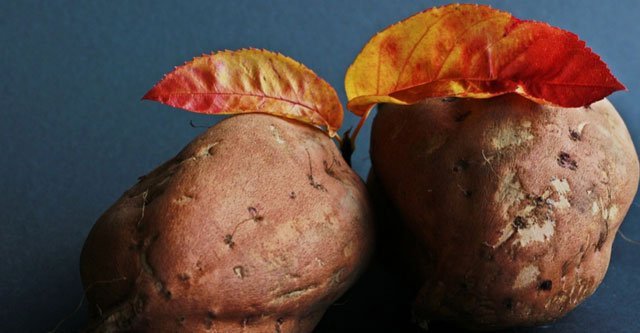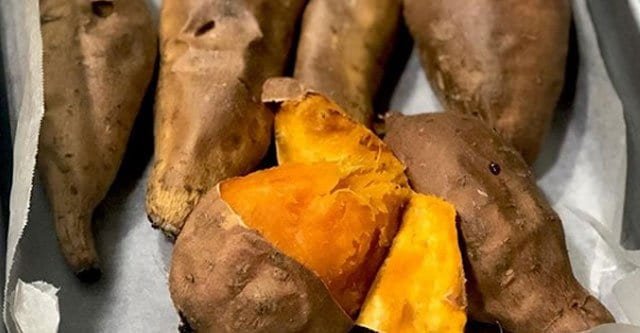Last Updated on September 4, 2020 by Dr Sharon Baisil MD
The healthy changes one needs to inculcate in their diabetic lifestyle include regular walks, yoga, and meditation, following proper sleep patterns, taking prescribed medicines and insulin according to doses prescribed, and, most importantly – keeping a check on what to eat and how much of it.
Choosing what to eat, the portions to consider, ways to cook certain food, etc. become valuable pointers to take care of. One such food that one has to consider a little research about before including in the diet is the Sweet Potato.
Is it safe to eat Sweet Potatoes by diabetic patients?

Well, to answer it accurately, it depends on the way you eat it and how much. Diabetic patients can take sweet potatoes, but with certain restrictions and rules.
Sweet potatoes are generally known for their carbohydrate and sugar content. There are several varieties of sweet potatoes found everywhere, and there are many ways even to cook it and be included in different recipes.
Sweet potatoes are not only delicious but also very rich in many nutrients. Considering a safe portion of this starchy fibrous vegetables can be beneficial to your body, even if you have diabetes.
First of all, let us talk about the Glycemic Index of this vegetable. The Glycemic Index is a measure that is used to determine whether a particular food item is safe to be consumed by diabetics or not. It takes into account the number of carbohydrates and other nutrients present in the food item and how it can impact one’s blood sugar levels.
Although different people have differences in their metabolic rates and functioning, no two people will have the same result in consuming the same food. General awareness of the food’s glycemic index can be a great help in managing proper food intake in your diabetic diets.
The various kinds of foods are classified based on their Glycemic Index as follows:
– Low GI – ranging from 0 to 55
– Medium GI – ranging from 56 to 69
– High GI – ranging over 70
The glycemic index is not always the same for a food item; it can vary depending on the way a food is cooked, taken raw, store-bought, processed in factories, added with preservatives, etc.
The fact that the Glycemic index of foods differs according to their cooking is exceedingly true for Sweet Potatoes. The Glycemic Index can range from low to even high when cooked in a specific method.
How much of the Sweet potato should be had by diabetics?

Well, as by now, we are aware that sweet potatoes are good for the health, but must be taken in regulated quantities if you have diabetes, therefore, let us discuss the recommended amount one can have.
Most sweet potatoes are big, and that much of an amount is not recommended. It is best to select medium-sized sweet potatoes and use only one for consumption. This will be around 80 grams of sweet potato. Lesser amounts are fine, but more than this quantity must be avoided.
Let us get into further details of how the Glycemic index differs from the variation in the sweet potato recipes:
Changes in the Glycemic Index of Sweet Potatoes with the changes in cooking method:
– Boiled Sweet Potatoes: Boiling is considered to be one of the healthy ways to cook food to reduce its effects on the blood sugars.
Boiling the starchy sweet potatoes helps the starch be broken down easily in the human body’s digestive system.
This prevents extreme spikes in the sugar levels in the blood.
Boiling also makes another excellent addition to the sweet potato, that is – it makes the vegetable to retain comparatively more resistant starch that is a kind of fiber that slows down the digestion process and releases sugars at a slower pace. Thus, the level of blood sugar rising dangerously is prevented.
The sweet potatoes have a low to medium range of Glycemic Index when boiled.
The more you boil it, the lower goes its glycemic count.
For instance, sweet potatoes that are boiled for around 10 minutes will have a GI of 61, which is moderate in the category.
When the sweet potatoes are boiled for a longer time, say for 30 minutes, the GI drops to a lower category and is about 46.
Therefore, boiling is an efficient way of adding sweet potato to your diet.
– Baking the Sweet Potato: Baking is another popular method of preparing the sweet potato. But this is not the perfect way to cook it if you have diabetes.
Baking the sweet potatoes tends to have a more significant effect on their glycemic index.
On baking, the Sweet potato becomes a high Glycemic Index item.
Baking a peeled sweet potato for about 45 minutes makes it high in GI, 94.
Sweet potato consumed in this way can have very sudden reactions on the body’s blood sugar count, and it can be problematic for diabetic patients. It is thus advisable to avoid having baked sweet potatoes by diabetics, pre-diabetics, obese individuals, and those trying to watch their diet.
Instead, you can stick to boiling the sweet potato for a longer time and then eating it to minimize its effects on the blood sugar levels.
– Fried Sweet Potatoes: As obvious as it sounds, frying is not the best option either. Frying anything makes it harmful for the body and its digestive functioning even though it can enhance taste and texture.
Well, the same applies when it comes to frying the sweet potatoes.
Frying adds to the fat content of the food.
When peeled and fried in regular vegetable oil, the GI of the sweet potato comes up to 76.
Frying adds up to the oil content that increases the fat in the food. As a result, the time required to digest the food increases, and the release of sugar in the body after digestion is slowed down. Hence, the GI count slightly decreases when compared to baking the same.
The fried sweet potato is although comparatively a better version than baking it.
Although the Glycemic index of the sweet potato is not as high as when it is baked, it still comes under the classification of High GI foods.
Thus, this can be affecting your body’s blood sugar.
Also, the GI can lower or heighten depending on the type of sweet potato you are frying and the variety of oil used for frying.
– Roasting the sweet potato: Similar to baking, roasting also tends to increase the tendency of the sweet potato to be harmful to the body.
The process of roasting, as well as baking, cuts off the resistant starch that is fibrous and beneficial to the digestive system and the gut. It also results in a higher Glycemic Index.
Roasting the sweet potato is not a great way to eat it as due to this, the glycemic index heightens.
The roasting process can add the Glycemic Index in the sweet potato, and it comes to around 82 when peeled and roasted.
Thus, unlike boiling the sweet potato, roasting it isn’t suitable for the body’s blood sugar levels.
What is the best way to cook sweet potatoes?

Thus, from the above-mentioned processes of cooking the sweet potato in different ways, it is best to opt for a boiled version. Boiling preserves the goodness and adds to its already existing fiber content, which is excellent for the gut system.
Apart from that, the Glycemic Index for sweet potatoes is the least when cooked by boiling it in water. It tends to decrease with the increase in its boiling time. Hence, you can boil your sweet potatoes for longer.
You can add some spices and flavors to your boiled sweet potato or even add boiled sweet potatoes to salads, sandwiches, and soups, mash it to enjoy its creamy texture, or in such other recipes.
Steaming the sweet potato is similar to boiling, and it is another safe way to prepare your sweet potatoes for consumption based on your diabetes-related diet.
It is ok too, at times, to include a fried version of this starchy potato tuber, but make sure to only consume it once in a while and regulated quantities.
It is best to avoid roasted and baked varieties as they tend to increase the Glycemic Index of the sweet potato and increase the rapidity of blood sugar level rises. Make sure you follow the advised rules to prevent sudden splurges in the blood sugars and keep away the casualties.
Among the various types of sweet potatoes available, the orange sweet potato varieties are said to have a higher Glycemic Index. They can have a more significant impact on your blood sugar levels.
Sticking to Japanese sweet potatoes and purple sweet potatoes are better for patients who have diabetes.
It is also recommended to ask your doctor for a proper diet plan and to stick to it. If you notice any symptoms of the discomfort of worry when you have sweet potatoes, be sure to always reach out to your medical team for proper observation and checks.
The effect of sweet potatoes on the blood sugar levels and the overall human body:
Due to its high starch content, the sweet potato tends to be a food item that results in spiking the level of sugar in the blood flow. But at the same time, taking sweet potatoes in a controlled amount and cooking it per your diabetic diet is an excellent way to be cautious.
The presence of fiber in the sweet potato is a useful element as it slows down the digestion to a certain extent and, in turn, delays the rise of sugar levels in the body. Therefore, sweet potato is not so bad, after all, if you are a diabetes patient.
Sweet potatoes are a better option over regular white potatoes. They are healthier and also comparatively lower in the Glycemic Index.
Other nutritional benefits in the Sweet Potato include:
– Apart from fiber, which we already talked about, the sweet potato is rich in a variety of vitamins C, B-6, and K, and minerals. The sweet potato has a lot of minerals like iron, selenium, and calcium, which add to the Vitamin B and C reserves in the body.
– They are also a good source of antioxidants like beta-carotene, which assists in converting Vitamin A into more beneficial components. Some varieties also hold the antioxidant – anthocyanin that is great for the eyes.
– This vegetable also contains the right amount of protein, magnesium, phosphorus, zinc, Folate, and other such minerals.
– The fiber in these is very encouraging in maintaining gut health and keeping the digestive system healthy.
It is safe to choose low Glycemic Index varieties when it comes to sweet potatoes and stick to boiling or steaming it for consumption instead of baking, roasting, frying, or using other methods.
REFERENCES:
https://pubmed.ncbi.nlm.nih.gov/24000051/
https://pubmed.ncbi.nlm.nih.gov/22895968/
https://pubmed.ncbi.nlm.nih.gov/26272174/
https://pubmed.ncbi.nlm.nih.gov/22336861/
https://pubmed.ncbi.nlm.nih.gov/23235674/
https://pubmed.ncbi.nlm.nih.gov/26905863/
https://pubmed.ncbi.nlm.nih.gov/26936648/
https://pubmed.ncbi.nlm.nih.gov/26936870/
https://pubmed.ncbi.nlm.nih.gov/31636690/
https://pubmed.ncbi.nlm.nih.gov/25707985/
https://pubmed.ncbi.nlm.nih.gov/30477357/
https://pubmed.ncbi.nlm.nih.gov/21845749/
https://www.healthline.com/health/diabetes/sweet-potato-diabetes#varieties
https://www.healthline.com/nutrition/sweet-potato-glycemic-index





